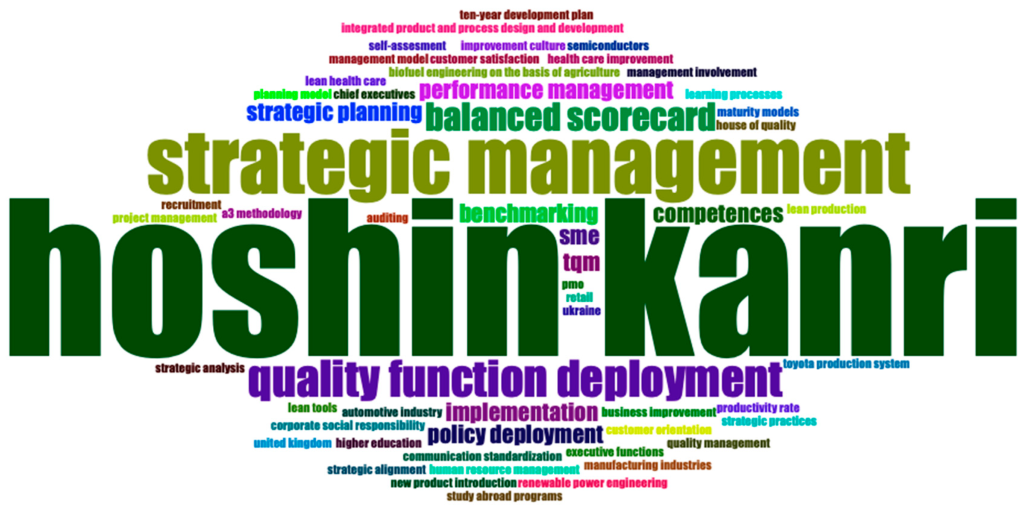What is Hoshin Kanri (Policy Deployment)


“The essence of strategy is choosing what not to do.” — Michael E. Porter
Introduction
It has never been easier to start a business and reach a seven-digit revenue. However, in the history of mankind, it has never been harder to make people care about your products. There is severe competition in every market, and only the smartest and the most dedicated survive. That is why companies need to make sure they have a well-thought-out strategy and can execute it relentlessly. It is not about having a strategy or execution. It is about both!
Read More: https://bit.ly/BalancedScorecard1992
Objective
Hoshin Kanri is a top-down approach, with the goals being decided by the management and the implementation being performed by employees. As a result, systems need to be in place to ensure that objectives from senior management are effectively communicated all the way down the level.
The principles of PDCA are heavily embedded into the Hoshin Kanri planning process. Beyond PDCA, Joseph Juran also played a role in spreading quality control principles that influenced Hoshin Kanri, specifically focusing on management’s role in the process. Hoshin Kanri bridges the gap between strategy and execution by creating alignment and focus.
Once you read this blog, you will understand, what is Hoshin Kanri, what are the 7 key steps, what is Catchball, what is X diagram, why it is important for any organization and how to implement it effectively in your organization.
Read More: https://bit.ly/DOJOCentre
Definition:
Efficiency (Cl 3.7.10): Relationship between the results achieved and the resources used.
Effectiveness (Cl 3.7.11): The extent to which planned activities are realized and planned results are achieved.
Read More: https://bit.ly/5SSteps
Detailed Information
Read More: https://bit.ly/KaizenMasaakiImai
The top management is aware that unless their company has a way to track and steer the progress of strategy deployment, the strategy is worth zero. Coordinating strategy implementation is challenging, especially in larger organizations, because leaders have their priorities and focus areas, which makes it challenging to maintain the necessary focus on the future.
There are several strategy deployment methods and they all have the same goal: to support organizations in executing strategic plans. To choose the most suitable method, managers need to consider the company’s organizational structure, maturity, and the business it operates in. Each method is top-down driven; however, the biggest differences between methods concern how strategy is cascaded down and how the internal alignment is handled.
Read More: https://bit.ly/Kirkpatrick4LevelModel
What is Hoshin Kanri?
Hoshin Kanri (Japanese: 方針管理, “policy management”) is a 7-step process (also called Policy Deployment) used in strategic planning in which strategic goals are communicated throughout the company at every level and then put into action. The Hoshin Kanri strategic planning system originated in post-war Japan but has since spread to the U.S. and around the world.
Translated from Japanese, Hoshin Kanri aptly means “compass management”. The individual words “Hoshin” and “Kanri” mean direction and administration, respectively.
“Building a visionary company requires one percent vision and 99 percent alignment.” — Jim Collins
A crucial detail about Hoshin Planning is that it is not executed strictly top-down. On the contrary, it is a joint effort between a manager and a subordinate who have to mutually agree on the optimal set of goals.
The benefit of discussing the goals with the people who will be actively working on them is that they will think through the details much more thoroughly than the management. Practically speaking, this is the essence of Catchball.
Having well-communicated, realistic, and agreed-upon goals is important because it enables ownership and motivation, creates a valuable feedback loop, and improves the commitment to the execution process.
Read More: https://bit.ly/CompetencyMapping1
Why it is Important?
The uncertainty in the industry is increasing day by day. Especially post covid and in the backdrop of the Russia-Ukraine war, nobody can predict the future securely.
“The biggest risk is not taking any risk… In a world that changing really quickly, the only strategy that is guaranteed to fail is not taking risks.” — Mark Zuckerberg, Founder & CEO of Facebook
The following are some key reasons that should force an organization to implement Hoshin Kanri
- Improved organizational alignment
- Increased ownership and engagement
- Easier decision-making and more consensus
- Solution orientation
- Widespread orientation
- Effective employee development
Read More: https://bit.ly/ROI-Training
How to Implement it?
The Hoshin Kanri Matrix, or X matrix, is a spreadsheet template that lays out the cascading goals, priorities, and projects that keep the entire organization focused on achieving breakthrough objectives
At the center of the matrix, you’ll find the four quadrants that represent your business strategy:
- Top-level priorities/Strategies (North)
- Metrics to improve (East)
- Breakthrough goals/Tactics (South)
- Annual objectives/KPI (West)
At the corners of the spreadsheet, you’ll see a series of boxes you can check to indicate dependencies between the activities linked to each of the main sections.
Another section allows you to define who is responsible for executing key tasks. It’s an effective tool for monitoring big-picture progress toward annual goals.
Read More: https://bit.ly/TraningNeedIdentification
7 Steps of Hoshin Planning (PDCA)
The Hoshin methodology follows a seven-step process for bridging the gap between strategy and execution. Here’s a quick overview of what’s involved at each stage.
“Victorious warriors win first and then go to war, while defeated warriors go to war first and then seek to win.” — Sun Tzu, Chinese philosopher and military strategist
- Establish Organization Vision: Define Mission, Vision, and Key Metrics. Hoshin Planning starts by defining the organization’s big-picture vision and purpose.
-
- Why does your company exist?
- Who do you help?
- What do you hope to achieve?
- How will you measure success?
- How will you know when you’ve reached your goal?
Here, the goal is to make sure that organizations have a clear direction for their strategy so that they can focus on the right objectives.
2. Develop Strategic Objectives: Identify Breakthrough Objectives. Breakthrough objectives refer to a set of vital, significant changes needed for the organization to realize its vision. These are big-picture goals, so the organization should try to keep this list short. While the general rule of thumb is under five, It is better to have two or three.
3. Develop Annual Objectives. After management has identified its breakthrough objectives, the next step is to set annual objectives for achieving those goals. Note that “annual” objectives don’t always operate on a one-year timeline. In some cases, a three-month or even 30-day turnaround is more appropriate.
From there, the organization should apply the Plan, Do, Check, Act (PDCA) Demings’s wheel to identify root causes, then use that data to develop an improvement plan.
4. Deploy Annual Objectives via Catchball. The next step is to deploy annual objectives using a technique called Hoshin Kanri Catchball, which is designed to create consensus about how objectives will be met through a top-down system of two-way feedback loops between managers and their direct reports.
5. Review Results on a Weekly, Monthly, and Annual Basis. “If you don’t know where you are going, you’ll end up someplace else.” — Yogi Berra, American baseball player. The management should review the process at regular intervals to measure their progress toward achieving key breakthrough goals. Here, the goal is to identify gaps between the actual and desired conditions, identify and address problems, and set new measurable targets to help the organizations to get back on track.
6. Problem-Solving. In this step, the organization can focus on problem-solving. Inevitably, there will be some missed objectives or areas that require a correction to be implemented in step five. Here, the company can follow the PDCA model for continuous quality improvement.
7. Annual Review: Reflect and Learn. The final step in the Hoshin Planning process is all about reflecting on lessons learned so that we can understand and grow from our daily work. Here, the organization should also standardize successful strategies and share key insights across your organization (Daily Work Management: DWM)
Read More: https://bit.ly/DailyWorkManagement
Industry Challenges:
- How often the employees in the organization are involved while setting the goals and objectives during policy deployment?
- How often the objectives and goals based on the strategy are realistic and implementable?
Read More: https://bit.ly/DifferenceCoachingMentoring
References:
ISO 9001: 2015
ISO 9002: 2016
ISO 9004: 2018
IATF 16949: 2016
Industry Experts
This is the 178th article of this Quality Management series. Every weekend, you will find useful information that will make your Management System journey Productive. Please share it with your colleagues too.
In the words of Albert Einstein, “The important thing is never to stop questioning.” I invite you to ask anything about the above subject. Questions and answers are the lifeblood of learning, and we are all learning. I will answer all questions to the best of my ability and promise to keep personal information confidential.
Your genuine feedback and response are extremely valuable. Please suggest topics for the coming weeks.

Recent Comments